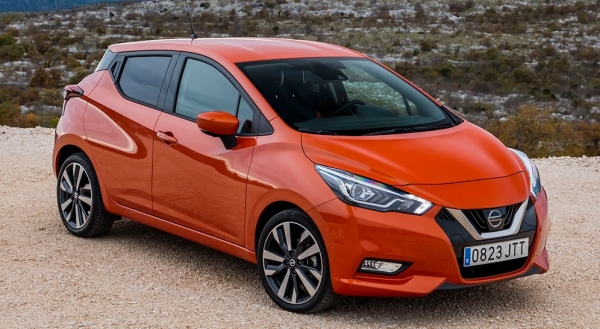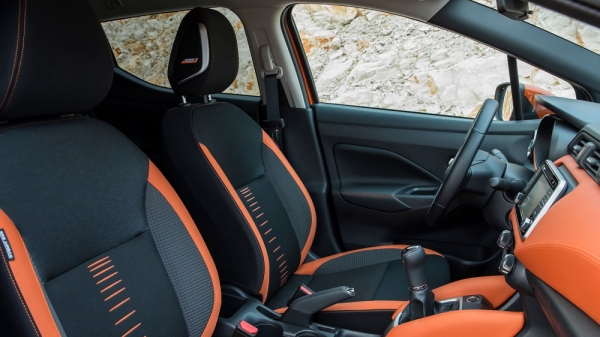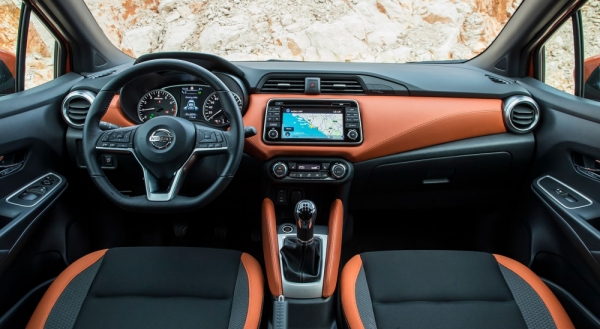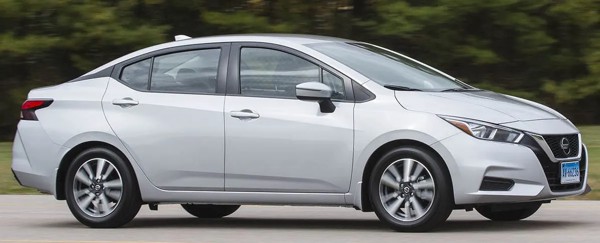Published
on 12
Jan 2017
|
All rights reserved.
|
|
|

|
|
The
5th generation Micra is striking enough to compensate for our loss
of faith in the past 7 years. |
|
We were deeply
disappointed with the last generation Nissan Micra/March. After the
very stylish Mk3, to which we awarded
Styling of the Year in 2003, the Mk4
suddenly switched to a boring design. Its build quality, materials and
features were also downgraded noticeably as its production was shifted
to Thailand and India. It seemed like Nissan simply rebadged a car
originally designed for developing countries and exported it to Europe
and Japan to fool the customers.
Fortunately, the strategy was proved to be a failure. Now Nissan has
corrected its wrong and spent extra effort to heal our broken hearts.
The 5th generation Micra is striking enough to compensate for our loss
of faith in the past 7 years. Sharp-looking, sporty driving and built
with near Volkswagen level of quality, it is clearly designed for the
European market. Will it be rebadged March and sold in Japan? I doubt.
Superminis don't sell in large quantities there, and Nissan already has
Note, Juke and Cube to serve the same purpose. In fact, freeing of the
influence of Japan and developing countries allows the Micra to focus
on driving dynamics and quality, which is good to us.

|
|
While
the old car was as soft and mushy as jellyfish, the new car’s exterior
design is sharp and sporty to the extent some might find it too radical
to live with. |
|
The styling change could not be more dramatic. While the old car was as
soft and mushy as jellyfish, the new car’s exterior design is sharp and
sporty to the extent some might find it too radical to live with. Up
front, there is a “V-motion” corporate grille dominating the nose.
Everything else – the V-shape bonnet, the wing-shape headlamps and the
left and right lip spoilers – looks like an extension from the grille,
extending outward and rearward to the sides of the car. The angles of
bonnet and windscreen are so fast that they are almost aligned,
creating a wedge profile. The roof line curves smoothly and dips a
little bit towards the tail, resulting in a streamline shape and an
excellent drag coefficient of 0.29. At both sides and the tailgate,
there are sharp crease lines pressed onto the sheet metal to change
light reflection and make the car looking heavily sculpted. The side
crease line dips dramatically at the middle of front door so to lighten
the visual mass and create a false impression of coke-bottle shape.
Higher up, all but the A-pillars are blackened, again to lighten the
visual mass. The rear doors kick up drastically near the C-pillars,
which adds character to the design at the price of rear quarter
visibility. Like Renault Clio, the rear door handle is hidden at the
C-pillar, though you won’t confuse a 5-door hatch with a 2-door coupe.
The tailgate is 3-dimenional but quite small. The rear screen is narrow
yet shallow, undoubtedly hampering rear view. No wonder the new Micra
offers rear-view camera, parking sensors and even a 360-degree parking
camera system.

|
|
The rear bench
is tight on headroom, blame to the dropping roof line...
|
|
Inside, the sporty shape compromises visibility and space. While the
front seats are roomy, the rear bench is tight on headroom, blame to
the dropping roof line. Knee room has no such problem though as the new
Micra runs a 2525mm wheelbase, 75mm longer than the old car’s. The rear
windows are not only small but also positioned high, so the rear seat
feels claustrophobic, and kids won’t be able to view out. Another blow
to the rear passengers is the lack of power windows – good old winders
return. At the back, the boot measures a generous 300 liters, but it is
not the most useful because when the rear seats don’t fold flat, and it
leaves a sizeable step at the load bay.
On the plus side, the design and build quality of the interior is
excellent. On the top trim, the two-tone dashboard is decorated with
faux stitch leather and color-matched with the seats and transmission
tunnel. Regardless of trims, the dash top and most surfaces you are
likely to touch are made of high-quality soft-touch plastics. Cheaper
hard plastics can be found lower down and at door panels, but this is
perfectly acceptable for a non-premium brand supermini. The instrument
reading is clear and attractive, thanks to a color TFT trip computer
display sitting between the two dials. The center console design is
dominated by a 7-inch touchscreen. The infotainment system works better
than most in the class. Overall, the build quality and tech of this
cabin trails Volkswagen Polo a little, but trumps it for style.

|
|
The design and
build quality of interior is excellent...
|
|
Measuring 4 meters in length, the new Micra is a massive 220mm longer
than its predecessor. Its body is 78mm wider, but the roof is lowered
by as much as 60mm to enable the sporty shape. It is finally well-sized
to match the norm of B-segment! Earlier rumors suggested it was built
on Renault-Nissan’s new CMF-B platform, but this is only partially
true. In fact, its component set is a mix of the CMF-B and the old
V-platform, which is closest to the new car in the form of Nissan Note.
This allows the Micra to reach the market faster yet is able to share
production costs with the next generation Renault Clio, which is still
2 years away. No wonder its production is shifted to the Clio plant at
Flins, France.
Regardless of platform, the mechanical layout is just the same. It
cannot escape from the class norm of MacPherson struts suspension up
front and torsion-beam axle at the rear, or fuel-saving electrical
power steering. It is said to feature a couple of advanced handling
technologies, but none involves any additional hardware. “Active Ride
Control” sounds like adaptive suspension but it actually uses soft
braking to balance the car over bumps, similar to Mazda's G-Vectoring
control. “Active Trace Control” is only another name of brake-actuated
torque vectoring.

|
|
The
car hits a sweet spot between the sharp handling of Ford Fiesta and the
comfort and refinement of Volkswagen Polo...
|
|
As the car is built alongside Clio, it is not surprising to know it
skips Nissan engines for Renault units. The 898cc 3-cylinder
port-injection turbo is taken straight from Clio and Twingo, producing
90hp and 103 lbft of torque. It is neither the sweetest revving nor the
most powerful 3-cylinder out there (that should be Ford’s 1.0 Ecoboost
or PSA’s 1.2 Puretech) as it is an older design, but it gets the job
done, running smoothly and quietly once it has overcome the turbo lag
under 2000 rpm. It works well with a slick 5-speed manual. Mile-eater
might opt for the 90hp 1.5 turbo diesel, whose 162 lbft of maximum
torque offers a slight advantage in performance, refinement and fuel
economy. Nevertheless, its extra weight at the nose blunts handling a
little. Later on, there will be a new 1.0-liter naturally aspirated
3-cylinder petrol with 73hp added as entry-level model. Nismo version?
Sadly, there is no plan at the moment. Its sporty shape definitely
deserves more power.
As for ride and handling, the car hits a sweet spot between the sharp
handling of Ford Fiesta and the comfort and refinement of Volkswagen
Polo. It feels agile in the twisty, if not as sharp as Ford. Its
steering is quick, precise and light. The suspension is stiff enough to
resist roll but a little more absorbent than the Ford. The dependable
grip, composure and fluency of cornering give you reassuring confidence
to have some fun on back roads. On cruise, its tires and suspension are
not quite as smooth and quiet as Volkswagen but still easily better the
old Fiesta – admittedly, the new Fiesta is certain to claw back some
points.
The new Micra is a versatile small car. Sharp looking, well built, good
to drive and comfortable – at least for the two up front. It is
probably not outstanding enough to get the top spot, but buyers will be
foolish to ignore it. |
Verdict:     |
Published
on 22
May 2020
|
All rights reserved.
|
|
Versa
|
|

|
|
Short
front, long deck and fat middle proportion is not quite as desirable as
Micra.
|
|
Versa is the smallest
Nissan sold in North America. Like the last generation, this one is
derived from the same platform as Micra hatchback. However, since the
Micra has shifted its focus from ASEAN countries back to Europe, the
Versa can enjoy also a vast upgrade in build quality. In fact, you can
see it as the sedan version of Micra, as it shares the much the same
chassis and interior. The only noticeable difference is more volume –
its wheelbase is stretched by 95mm to 2620mm, or 20mm more than before,
while the overall length is half a meter longer than the Micra. It
shares also much the same aggressive styling with its hatchback sister,
although its short front, long deck and fat middle proportion is not
quite as desirable.
Although the Versa is the entry-level Nissan in North America, its
interior is by no means cheap. Its Micra-donated dashboard is stylish,
built with better plastics and can be covered with leatherette if you
opt for higher trims. Likewise, the switchgears feels higher quality.
There are 3 colors to choose from, and a 7-inch touchscreen is
standard, so it looks far more interesting than the Nissan cheap cars
we used to know. Strangely, despite the longer wheelbase, it actually
loses 150mm of rear legroom from the old car. Not bad for a small car,
but rear passenger space is no longer a selling point. Moreover, the
sloping roof line makes rear headroom a little cramped.

|
|
Interior
is benefited from the Micra's attractive and high quality dashboard and
trims.
|
|
While its European sister is powered by turbocharged 3-cylinder
engines, the American version saves cost by using a conventional
1.6-liter naturally aspirated four-banger. It still employs port
injection, but has it upgraded to dual injectors each cylinder (like Suzuki’s
Dualjet) to enable better combustion. Spray-coated cylinder
bore reduces friction. Piston rings with higher thermal conductivity
and sodium-filled exhaust valves improve cooling, allowing the engine
to make more power and torque: 122hp and 114lbft. Still, it is not a
great engine, struggling to overtake and screams crazily on
acceleration. This is not helped by the Xtronic CVT that keeps the
engine working overtime. The cabin also lacks the sound insulation to
deliver decent refinement.
On the flipside, ride and handling is vastly improved from the old car.
Benefited with the Micra’s chassis, with twin-tube dampers, thicker
anti-roll bar, stiffer torsion-beam rear axle and better bump stops, in
addition to the car’s lower center of gravity and wider tracks, it
corners with much less roll, steers with higher precision and the
suspension deals with bumps more fluently. Driving fun is still out of
the question, but regular buyers should feel perfectly acceptable.
The new Versa is certainly a big leap from the old car, but still
hardly a contender for class laurel. The small cars from Honda and
Mazda are simply better and more desirable.
|
Verdict:    |
|